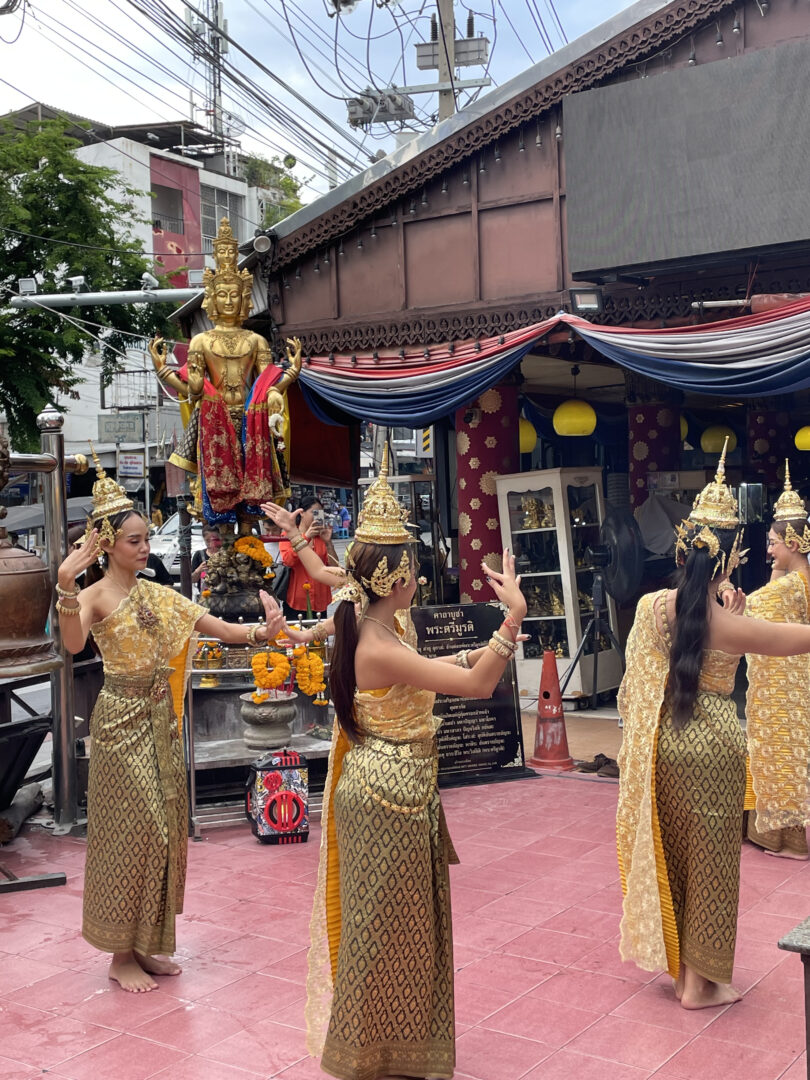Traditional Thai Dance on Bangkok Street Corner
There is an extended influence of ancient Khmer forms on Thai Classical dance and performance. This is due to the multitude of Khmer words relating to dance, music and performance, along with the similarities found between the gestures of Thai dancers’ depictions in ancient Khmer sculpture and bas reliefs.
“According to Surapone Virulrak, Thai performance art took shape during the Ayutthaya period. At this time, Chak nak Dukdamban, a “ceremony depicting the churning of the ocean to create the immortal spirit”, was performed on special occasions.This ceremony drew from the Indian epic of the Mahābhārata. Virulrak states, “These performing arts were gradually developed into Khon (masked play), lakhon nok (public dance drama) and lakhon nai (court dance drama) during the Late Ayutthaya Period (1456-1767)”, adding, “this period also enjoyed various imported performing arts from neighbouring countries.”
According to Paul Cravath, this ceremony was also depicted in bas-reliefs at Angkor Wat and could have been the forefather of Khon.[
Aside from folk and regional dances (such as southern Thailand’s Indian-influenced Manora dance), the two major forms of Thai classical dance drama are Khon and lakhon nai. In the beginning, both were exclusively court entertainments and it was not until much later that a popular style of dance theatre, likay, evolved as a diversion for the common folk who had no access to royal performances.
Classical dance
The first detailed European record of Khon and other Thai classical dances was made during the Ayutthaya Kingdom. The tradition and styles employed are almost identical to the Thai traditions we still see today. Historical evidence establishes that the Thai art of stage plays was already perfected by the 17th-century. Louis XIV, the Sun King of France, had a formal diplomatic relation with Ayutthaya’s King Narai. In 1687, France sent the diplomat Simon de la Loubère to record all that he saw in the Siamese Kingdom and its traditions. In his famous account Du Royaume de Siam, La Loubère carefully observed the classic 17th-century theatre of Siam, including an epic battle scene from a Khon performance, and recorded what he saw in great detail
The influence of Thai classical dance in neighboring countries
Thai classical arts exercised a strong influence on neighboring countries, especially Burma and Cambodia. The two golden periods of Burmese literature were the direct consequences of the Thai literary influence. The first transmission happened during the two-decade period (1564–83), in which the Toungoo Dynasty briefly managed to subject Siam as its vassal state. This conquest incorporated many Thai elements into Burmese literature. the most evident ones were the yadu or yatu (ရာတု), an emotional and philosophic verse and the yagan (ရာကန်) genre. The next transmission of Thai literary influence to Burma happened in the aftermath of the fall of Ayutthaya Kingdom in 1767. After the second conquest of Ayutthaya (Thailand), many Siamese royal dancers and poets were brought back to the court of Konbaung. Ramakien, the Thai version of Ramayana (ရာမယန), was introduced and was adapted in Burmese where it is now called Yama Zatdaw. Burmese literature during this period was therefore modelled after the Ramayana, and dramatic plays were patronised by the Burmese court.[
Cambodia had fallen into the control of Siamese hegemony around the reign of King Naresuan. But it was during the Thonburi Kingdom that the high cultures of the Rattanakosin Kingdom were systematically transmitted to the Cambodian court, which absorbed them voraciously. As Fédéric Maurel, a French historian notes:From the close of the eighteenth century and through the nineteenth century, a number of Khmer pages, classical women dancers, and musicians studied with Thai Ajarn (masters or teachers) in Cambodia. The presence of these Thai elite in Cambodia contributed to the development of strong Thai cultural influence among the Khmer upper classes. Moreover, some members of the Khmer royal family went to the Thai court and developed close relations with well-educated Thai nobility, as well as several court poets. Such cultural links were so powerful that, in some fields, one might use the term Siamization in referring to the processes of cultural absorption at the Khmer court at that time.







